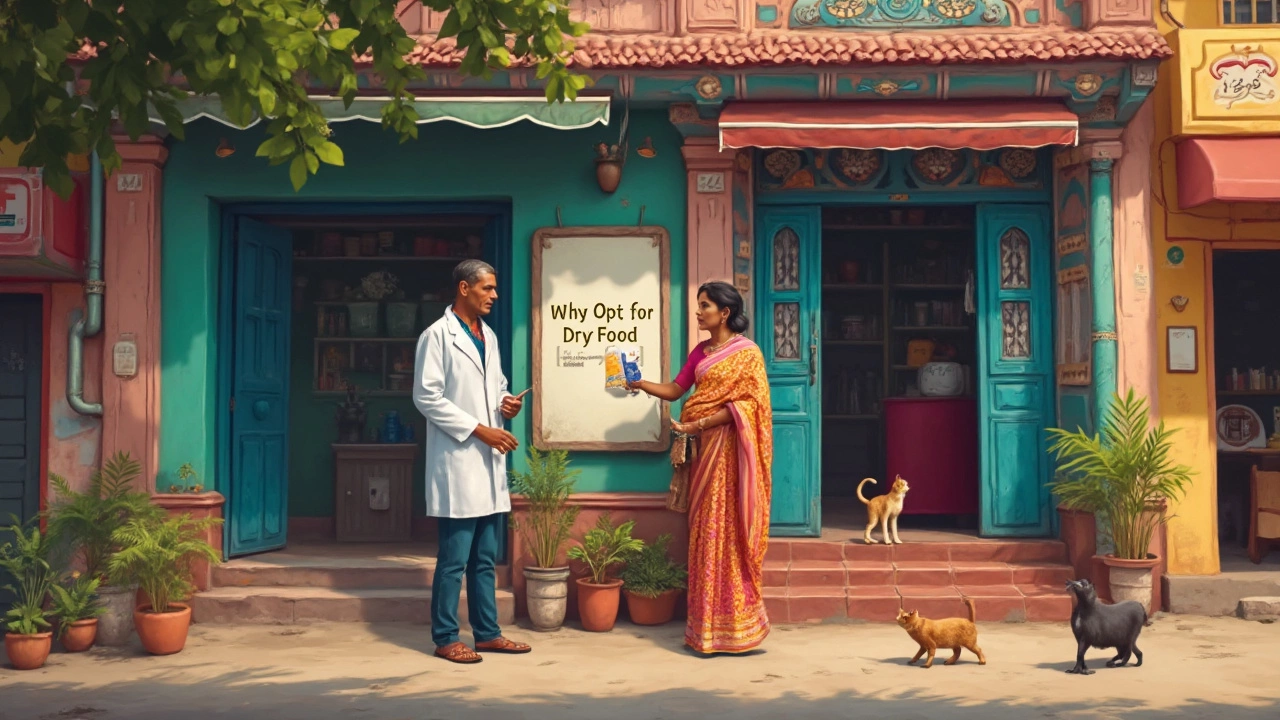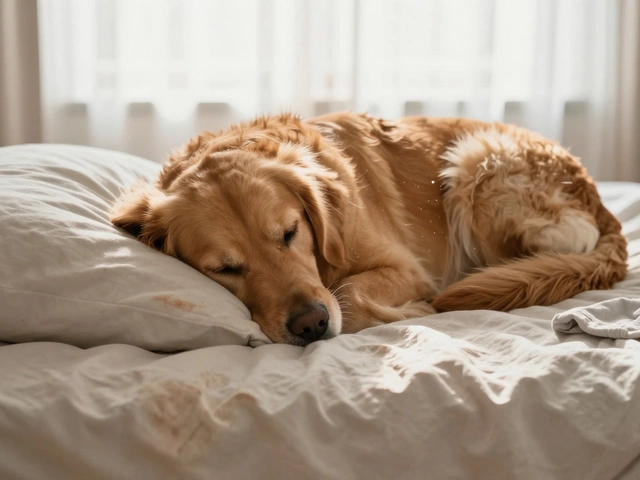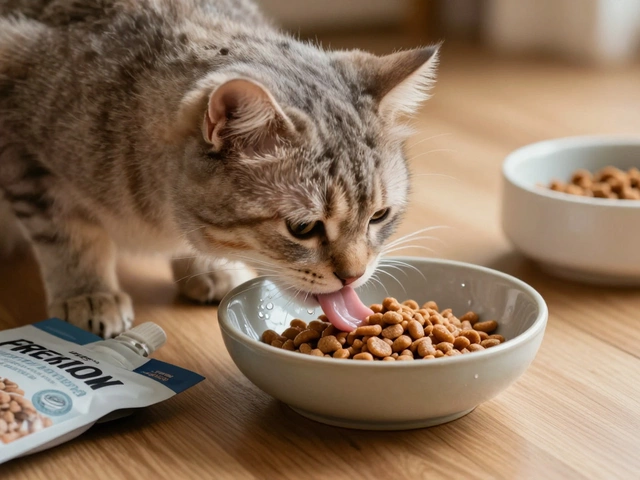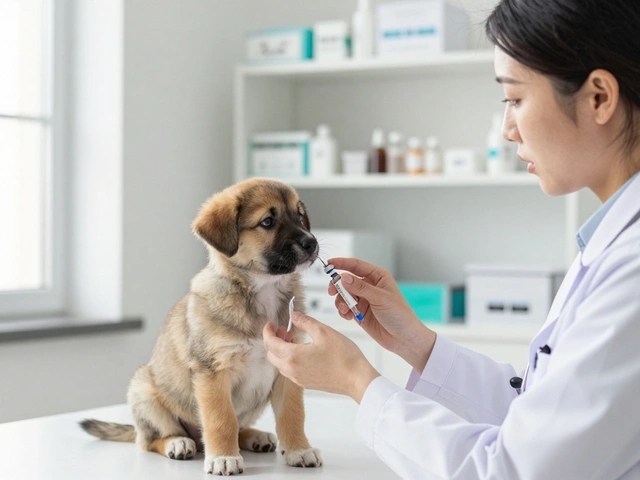
Ever noticed how many vets suggest dry food when you ask about feeding your cat? It's not just about convenience—though let's be honest, that's a huge perk. Dry food is often cheaper, stores easily, and those crunchy kibbles can do wonders for your cat's teeth. Yes, dentals are a big deal. Imagine munching on crackers after a meal—your cat's kibble works similarly to reduce tartar buildup.
Now, you might be wondering about nutrition. Can dry food really meet all those dietary needs of cats who are natural-born carnivores? Turns out, when made right, it can. Quality dry foods are crafted to be nutritionally complete, ensuring your furry friend gets essential proteins and nutrients. Plus, dry food tends to have longer shelf life, which is a bonus if you're the kind to stock up and forget. More on myths and facts in a bit—stay with me.
- The Convenience Factor
- Cost-Effectiveness
- Dental Health Benefits
- Nutritional Completeness
- Storage and Safety
- Debunking Common Myths
The Convenience Factor
Let's talk about why dry food is a go-to for many cat owners. It's all about ease. You can pretty much pour it from the bag, and you're done. Think about those mornings when you're in a rush—just scoop some kibble, and your cat's ready to feast. No need for a can opener or extra cleanup.
Easy Storage
Dry food is known for its long shelf life. Once you open a bag, it's good for months when stored properly in a dry, cool place. Compare that to wet food, which needs refrigeration and can start to spoil pretty quickly after opening. That's where dry food shines—it's low maintenance.
Feeding Flexibility
Another perk of dry food is that it allows for free feeding. You can leave it out all day without worries of it going bad. This is perfect if you're not home during the day or if your cat prefers grazing over set meal times. Just make sure your cat doesn't eat more than they need!
Travel-Friendly
Heading out for a weekend? Bringing a bag of dry food is much more manageable than hauling cans around. It's lightweight and doesn’t require special storage, making trips with your feline friend a lot easier.
The Cat Sitter's Dream
If you've ever had someone look after your cat while you're away, you'd know the simpler you can make it for them, the better. With dry food, it's straightforward. Just show them where the bowl and the bag are, and your sitter's job is practically foolproof.
Overall, the ease of use with dry food combined with its storage benefits makes it a top recommendation from vets for busy cat owners. It fits seamlessly into most lifestyles, allowing you to focus on enjoying time with your cat rather than worrying about their next meal.
Cost-Effectiveness
Alright, let's dive into why dry food is often recommended by vets for being easy on the wallet. First off, dry cat food tends to be a lot cheaper than its wet counterpart. You're getting more bang for your buck, especially if you're scooping cat food for a multi-cat household. Bulk-buying those big bags? Major savings right there.
But it's not just about the initial sticker price. Think about storage. Dry food has a long shelf life compared to wet food, which means less waste. You're not throwing out cans that expired or got yucky in the fridge. Each piece of kibble stays good for weeks, even months!
Breaking Down the Budget
Let's consider a scenario. Picture you're weighing between wet and dry options. You might find that, per serving, dry food costs significantly less. A typical mid-range dry food bag could bring down your daily feeding cost to mere cents.
| Type of Food | Estimated Cost per Day |
|---|---|
| Dry Food | $0.30 - $0.50 |
| Wet Food | $1.00 - $2.00 |
Beyond direct costs, there's added value. Trips to the vet for dental cleanings could be less frequent with the natural cleansing benefit of kibble. Less vet visits? That's cash saved straight away.
So, when you're puzzling over the best financial option while still wanting the best for your cat, dry food shines through. It's not just about upfront savings but about long-term budgeting benefits too.
Dental Health Benefits
Ever watched your cat munch on dry food and thought, 'Is this actually helping their teeth?' Well, you're onto something. Those crunchy bits in dry food are designed not just for nourishment but to aid in dental health.
Think of cat food kibbles like tiny toothbrushes. When your cat chews on them, the kibbles can scrape the surface of their teeth. This action helps reduce plaque buildup, serving as a natural cleaning mechanism.
Preventing Dental Problems
Let's get real—dental problems in cats aren't just a nuisance; they're costly. Vets agree that preventing them is way easier (and cheaper) than treating them. Dry food assists in keeping those plaque and tartar levels down, meaning fewer trips to the vet for dental cleanings.
- Reduction of Plaque: The abrasive texture of the kibbles helps minimize plaque on teeth surfaces.
- Fresher Breath: With less plaque comes fresher breath—a win for everyone involved!
- Healthier Gums: Consistently good gum health means fewer chances of other complications.
Do All Dry Foods Work Equally?
Not all dry foods are created equal when it comes to dental benefits. Some brands specifically design their kibbles to maximize dental care, offering formulas enhanced with enzymes or other dental-benefiting ingredients.
While vet recommendations often favor dry food, mixing it with a bit of wet food could make a balanced diet even more effective. But remember, for individual advice and tailored suggestions, it's always best to chat directly with your vet.

Nutritional Completeness
So, what does it really mean for cat food to be nutritionally complete? When we're talking cat food, the goal is to meet all dietary needs of your feline in each bite they munch. This involves a fine balance of proteins, fats, vitamins, and minerals. Now, here's where dry food shines—unlike some off-the-shelf canned food options, quality dry foods are often rigorously formulated to tick all these boxes.
Why dry food? For starters, it's packed with protein from meat sources, which are crucial for building strong muscles and supporting energy levels. Felines, unlike us, are obligate carnivores, meaning they rely heavily on meat-based diets. A well-crafted dry food contains these essential proteins and also a good amount of fats, which provide energy and help in absorbing vitamins.
Key Nutrients in Dry Food
Here's a snapshot of what you might find in a good dry cat food:
- Proteins: Vital for muscle maintenance and repair. Look for foods with chicken, fish, or beef.
- Fats: Supply energy and are needed for brain health. Omega-3 and Omega-6 fatty acids are often highlighted.
- Vitamins and Minerals: Essential for various body functions, ensuring skin health, vision, and bone structure.
- Fiber: Helps with digestion, keeping your cat regular.
But watch out—nutritional completeness also means avoiding things like fillers or excessive grains that your cat doesn’t need. It’s why checking the ingredient list is crucial when picking up any cat food bag.
Understanding Labels
One insider tip is checking for the AAFCO statement on the food label. It stands for the Association of American Feed Control Officials, and they set the standard for pet food nutrient profiles. If the label says it meets the AAFCO nutrient profiles, it usually means the food is up to snuff.
And just for a bit of clarity, let’s look at a quick comparison of nutritional elements commonly found in dry food:
| Nutrient | Dry Food | Canned Food |
|---|---|---|
| Protein (%) | 30-40 | 25-35 |
| Fat (%) | 15-20 | 10-15 |
| Moisture (%) | 5-10 | 75-80 |
See what I mean? Dry food really holds its own in the nutrient game—just keep an eye on those labels, and you’ll know you're making a smart choice.
Storage and Safety
Storing dry food for your cat might seem like a no-brainer, but doing it right can make a big difference in keeping the food fresh and safe. So, why’s it important? Well, properly stored food keeps your cat's meals up to par with the necessary nutritional value and taste. Plus, it prevents pesky critters or mold from sneaking in.
Keep It Sealed
First off, you've got to keep that food in an airtight container. After you open the bag, transfer the kibbles to something that seals well. This isn’t just about being fancy; it actually helps in maintaining freshness by blocking out moisture and air. You don't want mold spoiling the fun, right?
Location Matters
Where you store it also counts. Avoid dumping it somewhere too hot or damp—dry food loves a cool, dry spot. Think of it like keeping cereal fresh for yourself. A cupboard or pantry away from direct sunlight is usually perfect.
Watch the Expiry Date
No kidding, this one's crucial. It’s easy to forget how long that large bag’s been sitting there, but old food can lose nutrients and flavor. Set a reminder or write the open date on the packaging or container as a simple hack.
Be Mindful of Shelf Life
Quality brands often have a longer shelf life before opening, but once the bag’s open, it’s safer to use it up in around six weeks. Buying in bulk sounds smart until you end up with more than your cat can munch in that time frame.
Check for Unwanted Visitors
A sad truth: pests are pretty good at getting into anything tasty. Give the food a once-over occasionally, just to make sure no sneaky critters have made a new home. If you spot anything weird, it’s time for a new bag.
To wrap it up, with a few easy-peasy steps, you can keep your cat’s dry food in top condition, ensuring safety and happiness for your furry friend. Happy feeding!
Debunking Common Myths
When it comes to cat food, there are quite a few myths floating around that make choosing between dry food and wet food tougher than it needs to be. Let's toss some of those myths out the window, shall we?
Myth 1: Dry Food is Too High in Carbs
You've probably heard the chatter about dry food being loaded with carbs, right? While some brands might overdo it, most reputable ones understand the balance. Check those labels! Brands that care about their feline customers make sure the primary ingredient is meat and not fillers.
Myth 2: It'll Dehydrate My Cat
Cats are notorious for not glugging down water from a bowl. The myth here is that dry food leads to dehydration. A balanced diet is key. Pairing dry food with a good water source or occasional wet food can maintain your cat's hydration just fine without upsetting their health.
Myth 3: It's Not as Nutritious as Wet Food
This myth's got more bounce than a rubber ball. Here's the truth: Quality dry food brands ensure their products contain all essential nutrients, just like their wet counterparts. It might come as a surprise, but vets usually recommend nutritional completeness present in premium dry foods.
Myth 4: It Causes Urinary Issues
This one's scary for cat owners. While lower moisture in dry food could be a concern, the key is to encourage your cat to drink more water and perhaps tweak their diet with some moist food. Keep an eye on their behavior and adjust as needed to keep your kitty's urinary tract in check.
| Common Myth | Fact |
|---|---|
| Dry food is too high in carbs | Reputable brands focus on meat as the main ingredient |
| Causes dehydration | Balanced diet and water source prevent dehydration |
| Lacks nutrition compared to wet food | Quality dry foods are nutritionally complete |
| Causes urinary issues | Hydration and a balanced diet help maintain urinary health |
At the end of the day, whether you're choosing dry food for your cat depends on what works best for your pet and their little quirks. Armed with the right info, you'll find the right balance!





